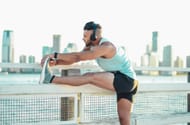Passive stretching is a well-liked and useful technique for improving joint mobility, reducing muscle tension, and improving flexibility.
In contrast to active stretching, which includes using muscles to move a joint through its range of motion, passive stretching entails relaxing while pressure from an outside source is applied to the joint to achieve a deeper stretch. In many yoga poses, rehabilitation regimens, and fitness disciplines, this type of stretching is frequently employed.
Instead of using your own strength to extend your muscles, passive stretching makes use of external forces. For instance, you can for a passive hamstring stretch, in place of touching your toes you use a strap or towel that has been rolled up.
Benefits of passive stretching

1) Increased flexibility
By lengthening the muscles and connective tissues, passive stretching aids in boosting joint flexibility and muscle length. Consequently, this enhances one's general range of motion and flexibility.
2) Decreased muscular tension
Passive stretching's slow, deliberate motions can ease tense muscles, causing them to become less rigid and encouraging a sense of relaxation. This may be especially helpful following strenuous exercise or extended periods of inactivity.
3) Improved circulation
Passive stretches cause muscles to elongate, which can increase blood flow and improve circulation. For the evacuation of waste products and the delivery of nutrients to muscles, improved blood circulation is necessary.
4) Prevention of injury
By preserving or increasing joint flexibility, regular passive stretches can help reduce the risk of injury. Strains, sprains, and other injuries are less common in flexible muscles and joints.
5) Reduced stress
By relaxing the nervous system, passive stretches can lower tension and encourage mental relaxation. Another way to promote calmness when stretching is to concentrate on taking slow, deep breaths.
Examples of passive stretches

Here are some examples of passive stretching:
1) Towel hamstring stretch
- Sit with one leg straight out in front of you on the floor.
- Feel the stretch in your hamstring by wrapping a towel over the foot of the extended leg and gently pulling back on it.
- After 15 to 30 seconds of holding the stretch, move on to the opposite leg.
2) Wall chest stretch
- Stand facing a wall at a shoulder-arm distance.
- With your hand on the wall, turn your body slightly away so you can feel the stretch in your shoulders and chest.
- Hold each side for 15–30 seconds.
3) Partner-assisted quad stretch
- Have a companion hold your ankles as you lie on your stomach.
- Your companion should aid you in gently applying pressure as you bend your knee and bring your heel towards your buttock.
- Replace your legs after holding the stretch for 15 to 30 seconds.
4) Doorway stretch
- Stand behind the door.
- For stability, put one foot slightly in front of the other.
- Raise your arms out to the side so that your palms are pointing front like goal posts and your elbows are bent 90 degrees. Let your forearms, elbows, and palms smack onto the doorframe.
- Maintaining your arms on the doorframe, gently lean forward.
- Hold for 10 seconds then repeat on the other side.
Any workout regimen would benefit from using passive stretching, which has several advantages including increased flexibility and stress reduction. These stretches can improve your physical performance and general well-being when added to your daily routine, either on your own or as part of a more extensive workout. As with any workout regimen, it's critical to pay attention to your body and refrain from overstretching.
